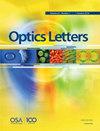利用CNLSE-Layer增强的光谱神经算子预测双折射光纤中的孤子捕获。
IF 3.3
2区 物理与天体物理
Q2 OPTICS
引用次数: 0
摘要
孤子捕获是双折射光纤中矢量光孤子中的一个重要现象。为了预测孤子捕获的产生,我们将耦合非线性Schrödinger方程(CNLSE)作为一层嵌入到神经网络中。在这里,我们的模型使用CNLSE-Layer来建模交叉相位调制算子,使用谱神经算子来建模群速度色散算子。该方法通过在损失函数中加入物理信息,有可能打破物理信息深度学习方法计算时间长的瓶颈。这项工作提出了一种新颖的,据我们所知,在神经网络中嵌入物理信息的设计范式。本文章由计算机程序翻译,如有差异,请以英文原文为准。
Predicting the soliton trapping in birefringence optical fibers via spectral neural operator enhanced by CNLSE-Layer.
Soliton trapping is a crucial phenomenon among vector optical solitons in a birefringent fiber. To predict the generation of soliton trapping, we embed the coupled nonlinear Schrödinger equations (CNLSE) as one layer into the neural network. Here, our model employs the CNLSE-Layer to model the cross-phase modulation operator, with the spectral neural operator for modelling the group velocity dispersion operator. The proposed method has the potential to break the bottleneck of the high computational time for physics-informed deep learning methods by adding the physical information in the loss function. This work presents a novel, to the best of our knowledge, design paradigm for embedding the physics information in neural networks.
求助全文
通过发布文献求助,成功后即可免费获取论文全文。
去求助
来源期刊

Optics letters
物理-光学
CiteScore
6.60
自引率
8.30%
发文量
2275
审稿时长
1.7 months
期刊介绍:
The Optical Society (OSA) publishes high-quality, peer-reviewed articles in its portfolio of journals, which serve the full breadth of the optics and photonics community.
Optics Letters offers rapid dissemination of new results in all areas of optics with short, original, peer-reviewed communications. Optics Letters covers the latest research in optical science, including optical measurements, optical components and devices, atmospheric optics, biomedical optics, Fourier optics, integrated optics, optical processing, optoelectronics, lasers, nonlinear optics, optical storage and holography, optical coherence, polarization, quantum electronics, ultrafast optical phenomena, photonic crystals, and fiber optics. Criteria used in determining acceptability of contributions include newsworthiness to a substantial part of the optics community and the effect of rapid publication on the research of others. This journal, published twice each month, is where readers look for the latest discoveries in optics.
 求助内容:
求助内容: 应助结果提醒方式:
应助结果提醒方式:


